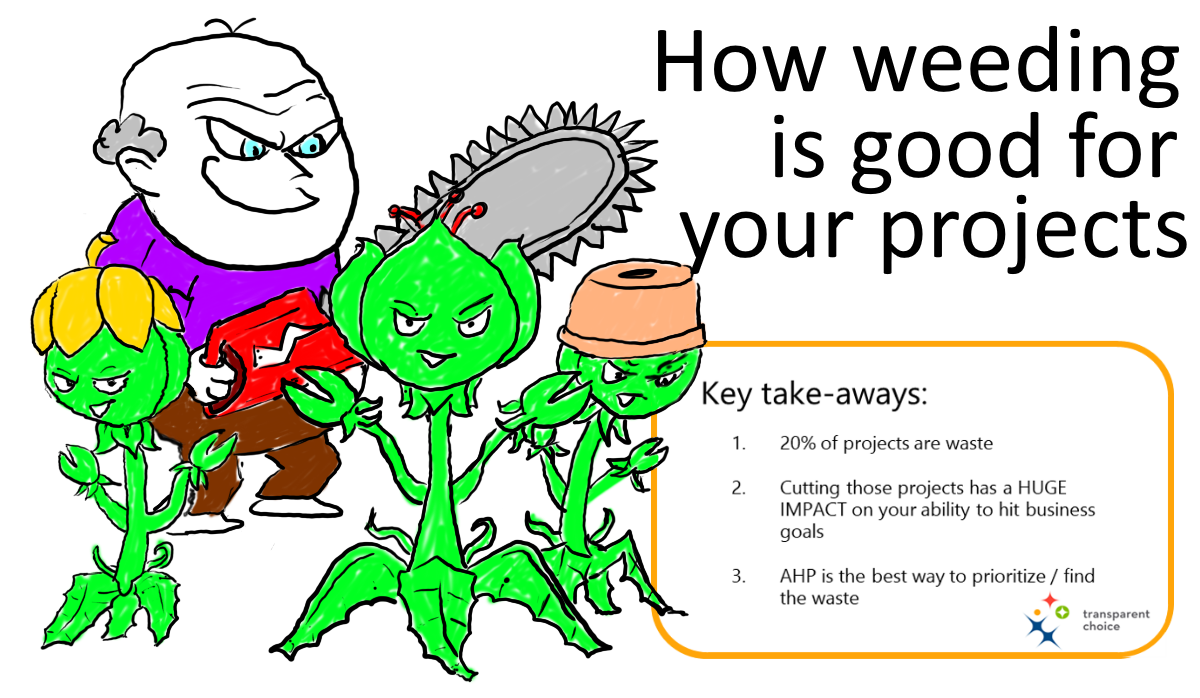Urgent action for all PMOs: Weed your projects!
Updated:
Published:

Everyone knows that an Englishman loves his garden, and I am an Englishman. Having said that, my wife tells me I don’t so much “do gardening” as “go to war with the garden”. I do love a good chainsaw…
But even I know that, if you want your flowers to bloom or your carrots to grow, you need to weed. You need to cut back overhanging trees and prune the deadwood.
Weeding reduces competition for water, nutrients and sunlight. These extra resources are then available to the plants that you really want to flourish. The payoff is more flowers and yummy fruit and veg!
And so it is with your project portfolio. Projects that don’t support your business goals are stealing resources and focus from the projects that can really move you towards your business goals.
20% of projects should be stopped
The PMI and the Economist Intelligence Unit did some research that shows that, in a typical portfolio, 20% of projects are so badly aligned with the goals of the organization that they should be stopped.
When I talk to prospects, this statistic often generates both nervous laughter and comments along the lines of “I wish it was only 20%.”
This is a shocking waste of your organization’s resources. It’s a waste of people’s time and creativity.
But for the PMO, this is also hurting your credibility. Execs are frustrated;
“I give you all these resources and budget, but we still can’t deliver on our strategic goals!”
And at the end of the day, delivering on those goals is the whole point of the PMO, so anything that reduces your ability to deliver on those goals undermines the PMO.
The solution: weed out weaker projects
The solution to this is obvious. Simply stop doing the 20%, the “weeds” that are stealing resources from the projects that add real value. That would allow you to focus your resources on the remaining projects.
Killing the bottom 20% of projects acts as fertilizer for your portfolio, allowing it to generate more “fruit” (the strategic goals / desired business outcomes).
This video shows an experiment you can do yourself to see what kind of a difference cutting the 20% can make. All you need is a large table (or other horizontal surface), 4 Post-it notes (or something similar) and a box of matches.
First, mark one Post-it as “Start” and another as “Goal” and put them around 1 metre / 3 feet apart on the table.
Next count your matches and then mix them up on the table. Make sure they are randomly oriented. These matches represent projects with a positive RoI (or NPV or other financial metric). But we care about more than just RoI. We also need to move towards our strategic “Goal”… and projects can take you towards your goals… or they can take you away from those goals.
That’s what the orientation of the match tells you. The match/project points in the direction of the match-head.
So what I want you to do is pick up a match and, keeping its orientation constant, place it on the “Start.”
Now pick up another match and, keeping its orientation, place it head-to-tail with the first match. Repeat this until all your matches are on the table forming one long “snake” (play the video to see what I mean).
Place one of your remaining Post-its (labelled something like “Before weeding”) next to the final match. How close is this Post-it note to your “Goal”? Chances are the answer is “not very!”
Now comes the tricky part.
Look for the 20% of matches that are pointing the wrong way – that means the ones that have the heads pointing away from your “Goal” - and take them off the table. Weed them out. Get rid!
Feels good, doesn’t it.
Now, rearrange all your matches end-to-end like you did before, taking care to keep the alignment the same (again, watch the video to see it in action).
As you lay the last match, place your final Post-it note labelled something like, “With weeding”.
So, here’s the question; which of the with/without weeding Post-its is closer to your “Goal”?
No competition, right? Taking out the 20% of projects that aren’t aligned to your goal makes a huge difference! When I did the experiment, I moved about 2x further towards my “Goal” after weeding then I did before (see picture below or, better yet, watch the video to see for yourself).

AHP is the best weedkiller!
Right, about now you should be feeling the fire of righteousness coursing through your blood… you are probably ready to run into the CEOs office and demand that she supports your urgent need to prioritize your portfolio and to weed out the rubbish.
Before you do, however, I’d like to suggest you pause to read a little about HOW to do prioritization - because it turns out it’s harder to weed out projects than it is to correctly prune a wisteria plant in the winter!
Trust me, I’ve done both.
The best start would be to download the Ultimate Guide to Project Prioritization, but at the risk of letting a spoiler the size of a Giant Redwood out the bag, the best way to prioritize projects is to use a method called the Analytic Hierarchy Process (AHP to its friends).
AHP sounds a little scary, but it’s not. You can learn why AHP is the “best” way to prioritize projects here.
So, there are just the 3 take-aways from this blog;
- 20% of projects in a typical portfolio are so badly aligned with business goals that they should be stopped,
- If you stop the 20%, it makes a HUGE IMPACT on your ability to hit your business goals,
- The best tool to use to weed out those weak projects is AHP.
So what are you waiting for? Put on some gardening gloves, grab a chainsaw and join me happily hacking away at that deadwood!

